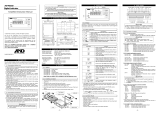
1
CONTENTS
1. INTRODUCTION .............................................................................................................................3
1-1 Features ............................................................................................................................................. 3
2. PRECAUTIONS ..............................................................................................................................4
2-1 Unpacking........................................................................................................................................... 4
2-2 Precautions Before Use...................................................................................................................... 4
2-3 Precautions During Use...................................................................................................................... 5
3. SPECIFICATIONS...........................................................................................................................6
4. FRONT PANEL ...............................................................................................................................8
5. REAR PANEL ...............................................................................................................................10
5-1 Description of Each Terminal............................................................................................................ 10
6. COMPONENTS AND FUNCTIONS ..............................................................................................14
6-1 Flowchart .......................................................................................................................................... 14
6-2 Description of Functions ................................................................................................................... 15
7. CALIBRATION ..............................................................................................................................17
7-1 Description of Calibration ................................................................................................................. 17
7-2 Calibration Modes............................................................................................................................. 18
7-3 Digital Span Mode ............................................................................................................................ 19
7-4 Calibration Mode .............................................................................................................................. 21
7-5 Full Calibration Mode........................................................................................................................ 22
8. FUNCTION MODE ........................................................................................................................24
8-1 Setting a Function............................................................................................................................. 24
8-2 Description of the Function Items..................................................................................................... 25
9. HOLD FUNCTION.........................................................................................................................29
9-1 Basic Operation ................................................................................................................................ 29
9-2 Hold Modes ...................................................................................................................................... 30
10. COMPARATOR FUNCTION........................................................................................................32
10-1 Simple Comparator Mode............................................................................................................... 32
10-2 2D Comparator Mode ..................................................................................................................... 35
10-3 2D Comparator Mode (By COMP 1 to 5 inputs)............................................................................. 36
10-4 2D Comparator Mode (By time control).......................................................................................... 39
10-5 2D Comparator Mode (Additional Explanation).............................................................................. 42
10-6 Comparator Hysteresis Function.................................................................................................... 43
11. ANALOG OUTPUT......................................................................................................................46
11-1 Analog Amplifier Output (AAO) ....................................................................................................... 46
11-2 Digital to Analog Voltage Output (DAV) .......................................................................................... 47

























